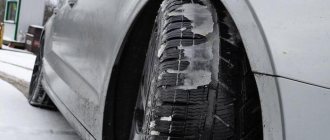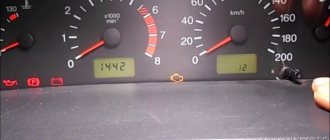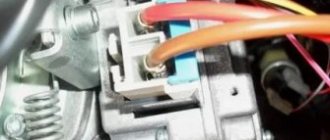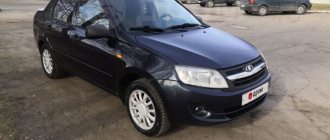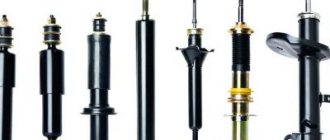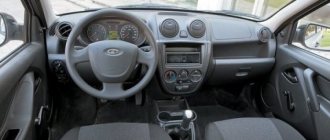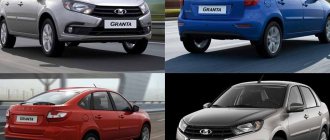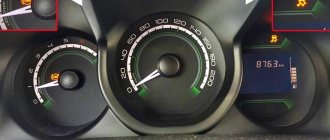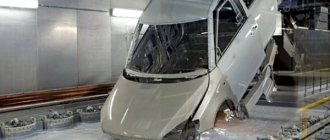An experienced motorist can easily distinguish between normal vibrations when accelerating and a cause for serious concern. In the first case, an increase in engine speed and vehicle speed will inevitably affect the level of comfort; in the second case, the source of increased shaking will be a specific malfunction.
Please note that such symptoms require diagnosis and immediate elimination. The point is not only an unpleasant beating on the steering wheel and an increase in noise in the cabin, but also a decrease in the level of directional stability and the likelihood of progression of the malfunction. The latter factor can lead to expensive repairs.
Let's start listing with the most banal and common reasons.
Causes of steering wheel vibration when driving
Everyone should know why the steering wheel wobbles when driving in order to correctly solve this problem:
- Wheel imbalance due to large amounts of dirt or stuck snow;
- Steering wheel vibration at speeds of 100, 120 km/h when the wheels are unbalanced;
- Poor quality discs (defective);
- Insufficiently inflated wheels;
- Poor quality wheel fastening;
- Problems with the suspension;
- Beating at idle;
- Vibration in the steering wheel when braking.
Wheel alignment and tire quality are another reason for shaking
If the wheel alignment angle is incorrect, vibration, the car pulling to the side, uneven eating of rubber and other unpleasant manifestations are possible. In different models, these problems manifest themselves in different aspects. Adjusting the wheel alignment angles is one of the first processes that needs to be performed after detecting such a nuisance as body vibration.
Problems can also be caused by tires that are worn incorrectly, or a disc after a serious impact. The main processes that can be taken to eliminate body vibration in this case are as follows:
- adjusting the wheel alignment angle at a wheel alignment station;
- replacing tires if there are visual indicators of uneven or excessive wear;
- replacing or repairing a disc that shows dents and uneven rims;
- performing wheel balancing - often during operation the balancing weights fly off.
If the balancing weights have come off the wheel, this may well cause vibrations at speeds of 80 kilometers per hour. The problem is that it is simply impossible to determine this yourself and find out which wheel needs to be sent for balancing. Therefore, you will have to go to a tire shop and have all the wheels of your car balanced.
This is one of the most inexpensive and safest options for breakdowns due to vibration of the body or steering wheel during acceleration. Therefore, the first thing you need to do is check for the presence of such faults, and then transfer suspicions to other options.
Steering wheel vibration at speed due to wheel imbalance
A common cause of this problem is the accumulation of a large amount of soil or snow on the tires. This deficiency often appears for a while. As practice shows, vibration on the steering wheel disappears at a speed of 100 km/h, but may return after a few minutes. It is easy to find out the reason for the steering wheel beating at speeds of 100, 120 km/h with alloy wheels. If you have them made of steel, this will not be so easy for the driver to do, because the ventilation holes here are small. Lumps of earth often collect inside the disk and are not visible to the naked eye.
In order to use only the best consumables when caring for your car, we recommend that you familiarize yourself with the rating of motor oils.
Steering wheel beating at speeds of 100, 120 km/h when the wheels are unbalanced
Everyone knows that the tires and wheels on any car, be it a VAZ 2110, VAZ 2109, Audi, Renault, Ford or any other, will not be ideal in terms of evenness and composition. In addition, the weight of the wheels in different parts is not the same and when the car starts to move, the place that has a large mass will begin to pull the center of the wheel towards itself, which will be a centrifugal force.
Steering wheel wobble when driving due to damaged or poor-quality discs
Both in the VAZ 2110 and other cars, steering wheel vibration at speed can occur due to the fact that the wheels are curved. Any specialist in tire fitting will notice this fact. In addition to dents, there may also be factory distortions on the wheel. If your tires have already served you for several years, they are quite old - this can negatively affect the full operation of the steering wheel. Common signs of tire deformation include:
- poor, worn condition of the cord;
- potholes in the tires due to the fact that you previously fell into holes at speed;
- poor quality production, which can manifest itself in different ways.
With “bumps” on the tires, the driver will feel both poor steering wheel function and rattling of the entire car. When you pick up speed, you will only feel the steering wheel vibrating as you move. However, when you reach 90-120 km/h, you will hear the entire car operating incorrectly.
see also
Comments 47
Just like mine, 1:1, and I changed the drive and the brake discs vibrate even if you crack it, it’s already drained my whole soul. It's a pity that we couldn't find the reason...
A huge possibility is the steering rack. Either change it or improve it.
I'll have to look, it's just knocking on me, thank you)
They come from the factory unlubricated, which is why they break immediately. Apparently for you and me it also came out with some play.
Yes, may be. It seems like it was never touched from the factory, although at the maintenance they said that it was adjusted (the nut was clogged once at the factory and remained so). Last year I added lubricant through the anthers, maybe it became a little easier to walk
If they are dealers, then they are lying. I had to drive the car to them three times. Engine problem. Until I filed a complaint, the car was not repaired. There was a factory defect. The pistons were installed with a smaller diameter. And there were three such cars in our city.
Yes, off dealer. I swore because of the knocking of the rack when it was cold, it was also a whole epic
interesting topic . I have a service liftback. same problem . did you find a solution?
Don't know. I haven't had this car for three years now. At the moment my version is the steering rack. Most likely it comes with a defect and has a backlash. The play may appear at speed.
Same crap, mileage 25 thousand after a couple of big potholes - killed 2 discs, vibration appeared at speeds of 90-110, at the station they say everything is fine with the suspension, straightened the broken discs and threw them back. (vibration is felt in the pedals and steering wheel)
Maybe you also damaged the steering rack?
Anything can happen... So what now to change the wheel bearing, CV joint assembly, rods, levers, disc, rack and steering wheel at the same time? ))
I think start with something simple. Install the amplifier shield on the steering rack. It doesn't cost much. Because when I was struggling with vibration, I replaced the entire right-hand drive assembly and nothing changed. Only about 8 thousand rubles. thrown to the wind. If it hits the pedals, I'll try replacing the brake discs. Perhaps they were not sharpened smoothly when braking.
And sometimes at a speed of about 100 km/h I have vibration, and sometimes there is none. Depends on where you're going. Although the asphalt seems to be smooth and this was not the case with other cars in these areas. As a result, I scored and decided that this was the coating.
I also noticed this phenomenon, you drive in 5th gear, the speed is 110-120 km/h, you press the gas pedal to accelerate, there is no vibration, as soon as you release the gas pedal to coast or drive down a mountain, when you don’t load the engine, vibration appears.
I just had a smooth ride. without acceleration and without coasting. it even looked like a slight beating. At first I even thought that the wheels were not screwed on well and checked all 4 wheels at once, but everything turned out to be normal.
About overclocking, I tried it, how the shaking manifests itself.
I once wrote about approximately the same problem. It (the problem) lies in the operation of the gearbox differential, or rather the satellites - with different loads on the wheels, the transition of forces from one axle shaft to another, especially when turning, can cause a slight vibration. It's front-wheel drive, that's how it should be. I also experience vibration at about 100 mph under light loads.
Beating in the steering wheel: First joke: it depends on the imbalance of the tires - mine was from 70-90, then it went a little higher - the solution is stupid - I moved the front to the rear, reeled in another 3 thousand - silence. Then I went to the winter ones, in the spring before changing shoes - I went to a neighbor's place - changed the weights - put them on as they were from the factory - silence. The second joke you can find out yourself: jack up the front on either side, don't put the car at speed, but just put the rear wheels in anti-roll mode on the handbrake pinch. You need a chalk and a lining: you put the chalk on the lining under the wheel - there is a gap of 1-2 mm and turn the wheel - where the rubber or disk sticks out, if it’s not “snapped”, but “by eye the gap has become larger - well, I put a point there. In general, vertical runout of a disk or rubber. Rubber: most likely change it, as an option, look for “nickels” on the surface - usually they are slightly chewed and the tread will show different wear. Disc: for repair at a GOOD STAND and in GOOD HANDS. The third joke: partially echoes the first and second: the tread is “eaten up” by “nickels” - the result is an imbalance of weight and unevenness of the tread, this is looked for by inspecting the tires in good lighting, the solution is - if there is little wear - balancing, if there is a lot of wear - change the stroller, in rare cases it saves chamber - changes the pressure distribution in the wheel. Example of wear (nickels are already large) - www.autoprospect.ru/volks...en/touareg/images/667.jpg
Steering wheel wobble at speeds of 100-120 km/h due to poor-quality wheel fastening
If your wheel nuts are not fastened firmly and securely enough, this is also the cause of vibration of the steering wheel and the entire car at speed. Loose nuts are one of the simplest and most easily diagnosed problems, but also the most dangerous. If you don’t pay attention to the incorrect operation of the wheels in time and while driving they fly off from your car, an accident cannot be avoided, which will end badly not only for you, but also for other people.
Repairing a car in the event of a “lost” wheel can cost a considerable amount of money if the problem is not diagnosed in time. In this case, it may be necessary to replace the brake disc, hub or other components. To be confident in your car, it is better to securely secure the nuts and bolts on the wheels or entrust the matter to professionals for maintenance.
Don’t forget about other important parts of the car; in particular, we recommend that you read the article on checking the battery charge.
Engine mounts, tie rods and other problems
There is another group of problems that cause vibrations when accelerating a car. It is difficult to collect these problems into one bundle, because they are all different and arise for various reasons. Vibration often occurs when one of the engine mounts is broken. This can easily be checked by increasing the speed while shaking.
The gearbox may also be the culprit for this type of problem. If the car starts to shake at 80 kilometers per hour, you can very easily check the fault of the gearbox by performing the following procedures:
- accelerate to a speed of about 85 kilometers per hour;
- depress the clutch and observe the vibration change;
- engage third gear and smoothly release the clutch;
- try accelerating from 50-55 kilometers per hour in last gear.
If the nature of the shaking does not change in all these experiments, the box has nothing to do with this problem. If there is more shaking when the gearbox is engaged, you will have to check whether it is involved in this problem.
How suspension malfunctions can cause steering wheel vibration when driving
If the suspension is worn out, its functioning will affect the full operation of the car and its contact with the road. When play appears, the same imbalance will arise when the steering wheel is rotated as when the car’s tires are insufficiently inflated. However, backlash cannot indirectly cause this problem; it will only act as a catalyst.
Transmission
The manual transmission has been modernized more than once. It now has a cable drive, thanks to which the gears are engaged with less effort, and the accuracy of the selection mechanism has increased. This box has the factory index VAZ-2181. But the sound when its gears operate is still too loud. The problem with the second gear synchronizer has not been completely resolved. Poor engagement and rapid wear of the synchronizer, despite numerous upgrades, still occur. As well as oil leaks through the seals. The reason is the low quality of the seals themselves and the insufficient accuracy of the positioning of the seal relative to the shaft. All this fully applies to the VAZ-2182 robotic gearbox, because it was created on the basis of a mechanical one.
In the case of gearbox 2181, the clutch mechanism rarely lasts more than 100,000 km, especially if the car is used in a big city and often sits idle in traffic jams. In robotic gearboxes, the clutch lives even less.
The only truly reliable transmission in the line is a 4-speed automatic from the Japanese company Jatco.
In extreme driving modes, the steering wheel “bites” a little in the near-zero zone, and the feedback could be clearer and more significant.
In extreme driving modes, the steering wheel “bites” a little in the near-zero zone, and the feedback could be clearer and more significant.
Steering wheel wobble at low speed and at idle
Also, difficulty with the occurrence of steering wheel vibration when turning right or left can be caused by insufficiently reliable fastening of the internal combustion engine to the car body. This leads to consequences such as:
- large feedback from the steering wheel at idle;
- vibration of the steering wheel when the car comes to a complete stop;
- deviations in the steering when starting the car;
- when squeezing the accelerator and increasing speed.
It is very simple to recognize the cause of such vibration in the steering wheel: a high-frequency beat occurs, the vibration completely depends on the number of engine revolutions. Consequently, as the speed increases using the gas pedal, the vibration becomes more frequent. The problem can also arise if the drive shaft is not operating correctly. However, this rarely happens.
Lada Granta Liftback 2014, l. With. - running-in
Cars for sale
Lada Granta, 2013
Lada Granta, 2017
Lada Granta, 2019
Lada Granta, 2019
This is interesting: Originals and analogues of parts, pistons and valves of the VAZ 11183 Lada Granta engine
Vibration in steering wheel when braking at speed
Pay attention at what point the steering wheel starts to wobble. If this process begins while the car is braking, then there is a high probability that the problem is hidden in the brake drums or discs. This indicates that the parts are deformed and their working surface has become uneven.
Components of a vehicle's brake system may be deformed for the following reasons:
- due to too long work and excessive wear;
- when overheating, when the driver presses the brake pedal too hard;
- cooling.
Taking into account these problems, the brake discs turn into wavy ones, and the shape of the drums changes from round to oval. However, the latter are more difficult to deform using the above methods. When deformation of parts occurs, vibration is felt by the driver only during light or hard braking, at a time when the pads begin to perform their task. As a result of this process, the entire braking system of the machine is exposed to vibration.
You can get rid of the problem only by purchasing new discs or drums for your car. To avoid vibration of the steering wheel at speed or when braking, carry out a routine technical inspection of the car and listen to the operation of the “steering wheel” while the car is moving.
